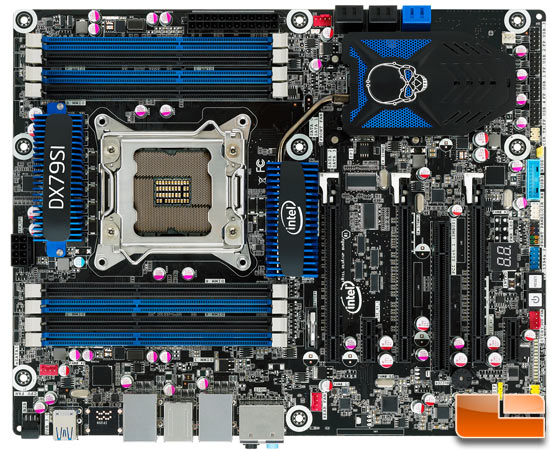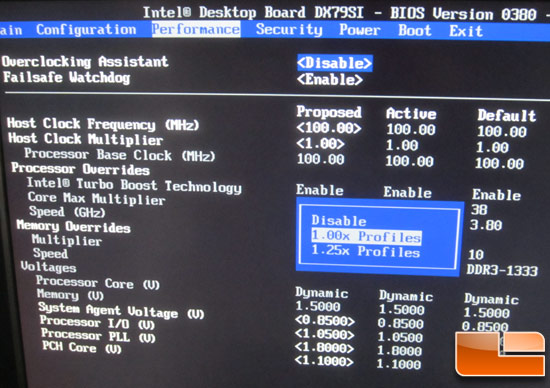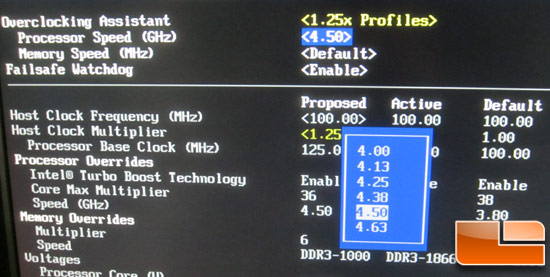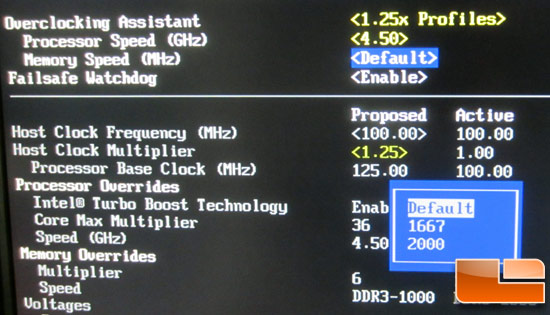Intel Core i7-3820 3.6GHz Processor Review
Intel Core i7-3820 CPU Overclocking
Overclocking greatly varies due to what hardware is being used and who is doing the overclocking. Always remember that no two pieces of hardware will perform the same, so our results will differ from what you might be able to get.

We have been using the Intel DX79SI ‘Siler’ motherboard as our CPU test bed and so far it has been working great. This board has a feature called ‘overclocking assistant’ that helps beginners and experienced users when it comes to overclocking!

To use the auto overclocking feature you need to enter the BIOS setup (Press F2 during the system POST) and go to the performance page. After accepting the legal disclaimer you can pick either a 1.00x gear ratio or 1.25x gear ratio for overclocking. We picked the 1.25x profile as it goes up to 4.63 GHz versus the 1.00x profile that it went up to.

The CPU overclocking assistant allows for selections that range from 4.00 GHz to 4.63 GHz. It sets all the voltages, turbo ratios, power and current limits for you automatically. We tried to get the Intel Core i7-3820 to run at 4.63 GHz, but it would blue screen during the Windows loading process. We had to back it down to 4.50 GHz and then it was rock solid and able to run Prime 95 overnight.

The default memory setting with the Intel Overclocking Assistant is a measly 1000MHz and that is way too slow for us. You can enter the override the memory clock speed and you can select from 1600, 1867 or 2133 MHz when using the 1.00 gear ratio or 1667 or 2000 MHz with the 1.25x ratio. For our overclocking we went with the 1667 MHz memory option.

At the end of the day we were able to take the partially locked Intel Core i7-3820 processor all the way up to 4.5 GHz with the Intel Overclocking Assistant. The system was stable when running stability tests like Prime95 and it was noticeably faster. By using the 1.25x ‘strap’ we were able to bump the base clock up to 125 MHz and this was critical for reaching this overclock! We could have increased the multiplier up to 37, but our processor did not like that setting.
Our readers have been asking for more than performance numbers when it comes to overclocking, so let’s take a look at what happens to the processor temperature, power consumption and overall system performance with this overclock.
| Intel Core i7-3960X | Stock Settings | 4500MHz OC Profile |
| Idle Temp | 26C | 28C |
| Load Temp | 50C | 66C |
| Idle Watts | 56.8W | 65.6W |
| Load Watts | 166W | 236W |
| Cinebench Score | 7.26 pts | 8.80 pts |
| X264 Pass 2 | 38.38 FPS | 46.14 FPS |
| 3DMark Vantage Overall | P20997 | P21825 |
| 3DMark Vantage CPU Score | 25266 | 30483 |
As you can see, the temperature was up 2C at idle and 16C at load despite the fact that we were using the Zalman CNPS12X CPU cooler. If the temperature increased that much you know the power usage is up, and indeed it was. Power consumption was up by ~9 Watts at idle and 70 Watts under full load (Prime 95). Intel designed the processor to work very power efficiently at stock speeds, but once you overclock it and increase the voltages you throw all that out the window.
The performance of the Intel Core i7-3820 was significantly better thanks to overclocking as one could imagine. Our Cinebench 11.5 score was 21% faster, the second pass of X264 HD was 20% faster and the CPU test in 3DMark Vantage was also 21% faster! Seeing at least a 20% performance gain is nice, but it increased the load power consumption of the entire platform 43% to get those gains.

Comments are closed.